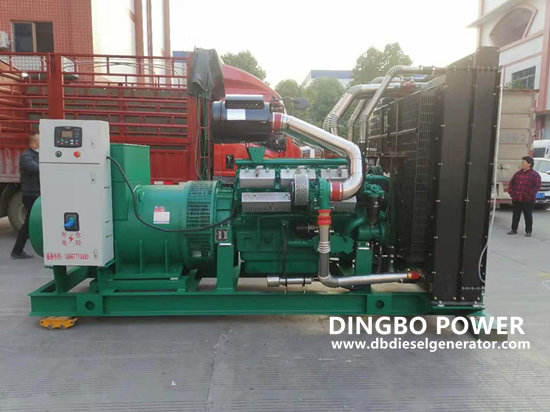dingbo@dieselgeneratortech.com
+86 134 8102 4441

- Home
- Products
- About Us
- Service
- News
- Technical Support
- Contact Us
dingbo@dieselgeneratortech.com
+86 134 8102 4441
Oct. 15, 2021
Causes of vulcanization of Cummins generator battery pole plates
The phenomenon that some active materials on the positive and negative plates of lead-acid batteries gradually turn into coarse lead sulfate crystals, which cannot be converted into lead dioxide and spongy lead during charging, is called sulfation of the plates, referred to as (plates) )vulcanization.
If the lead-acid battery is discharged for a long time, the soft and small lead sulfate crystals on the electrode plates will gradually become hard and coarse lead sulfate crystals. Such crystals will block the micropores of the active material on the electrode plates due to their large volume and poor conductivity. The penetration and diffusion of the electrolyte are hindered, and the internal resistance of the battery is increased. During charging, this thick and hard lead sulfate is not easy to transform into lead dioxide and spongy lead, resulting in reduced active material on the electrode plate and reduced capacity. In severe cases, the electrode plate loses its reversible effect and is damaged. The service life is shortened.

The recrystallization of lead sulfate causes the growth of crystal particles. Because the solubility of small crystals is greater than that of large crystals, when the sulfuric acid concentration and temperature fluctuate, the small crystals will dissolve, and the dissolved PbS04 will grow on the surface of the large crystals, causing the larger crystals to grow further.
There are many reasons for the vulcanization of the battery plates, but they are directly or indirectly related to the long-term discharging or under-charged state of the battery, which can be summarized as follows.
①In the discharge state for a long time. And make it unable to be charged in time and stay in the discharge state for a long time. This is the direct cause of battery vulcanization.
②Long-term insufficient charging, such as low float voltage or stopping charging when the battery is not charged to the termination mark, will cause discomfort in the long-term charging of the battery. The part of the active material that has not been charged will be vulcanized due to long-term discharge.
③ Frequent over-discharge or low-current deep discharge will convert the active material deep in the plate into lead sulfate, which must be overcharged to recover, otherwise vulcanization will occur due to failure to recover in time.
Lead-acid batteries that are not charged in time after discharge require timely charging within 24 hours after discharge, otherwise vulcanization will occur and cannot be fully charged within the specified time.
③ Frequent over-discharge or low-current deep discharge will convert the active material deep in the plate into lead sulfate, which must be overcharged to recover, otherwise vulcanization will occur due to failure to recover in time.
The lead-acid battery is not charged in time after discharge, it is required to charge it in time within 24h after discharge, otherwise it will be vulcanized and cannot be fully charged within the specified time.
④If the equalization charge is not performed in time, the lead-acid battery pack will be unbalanced during use. The reason is that the battery has been slightly vulcanized. Equalizing charge must be carried out to eliminate vulcanization, otherwise the vulcanization will become more and more serious.
During storage, charging and maintenance are not performed regularly. Lead-acid batteries of Cummins genset will lose capacity due to self-discharge during storage. Regular charging and maintenance are required, otherwise the battery will be in a state of depletion for a long time.
⑤The amount of electrolyte is reduced. The electrolyte level is lowered, so that the upper part of the electrode plate is exposed to the air and cannot effectively contact the electrolyte. The active material cannot participate in the reaction and sulfide.
⑥ The active material in the short-circuited part of the internal short-circuit is in a discharged state for a long time because it cannot undergo a charging reaction.
⑦Serious self-discharge. Self-discharge will quickly turn recovered lead or lead dioxide into discharged lead sulfate. If self-discharge is serious, the battery will easily be discharged.
⑧The electrolyte density is too high and the density is too high to accelerate the self-discharge speed of the battery, and it is easy to form coarse-grained crystals in the inner layer of the electrode plate. In addition, the density is too high will cause the misunderstanding that the battery is full and over-discharge when discharging, and the misunderstanding that the battery has reached the end of charge when charging, and the actual charge is insufficient, which will eventually cause vulcanization.
⑨ Too high temperature and high temperature will speed up the self-discharge of the battery, and it is easy to form coarse crystals on the inner layer of its plate.
For VRLA batteries, the lean-liquid structure and internal oxygen recombination cycle are also the main reasons for the occurrence of vulcanization. This is because on the one hand, the lean-liquid structure prevents some active materials from effectively contacting the electrolyte, and as the use time increases, the saturation of the electrolyte gradually decreases, and the active materials exposed to the air (oxygen) also increase. Part of the active material is also vulcanized because it cannot be charged; on the other hand, the oxygen recombination cycle causes the oxygen generated by the positive electrode to recombine in the negative electrode at the later stage of charging, so that the negative electrode is in an insufficiently charged state to prevent the precipitation of hydrogen, but at the same time, the negative electrode It is easy to cause vulcanization due to insufficient charging.
Quicklink
Mob.: +86 134 8102 4441
Tel.: +86 771 5805 269
Fax: +86 771 5805 259
E-mail: dingbo@dieselgeneratortech.com
WhatsApp: +86 134 8102 4441
Add.: No. 10 Kechuang Road, High tech Zone, Nanning, Guangxi, China